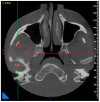A Morphometric Evaluation of the Mandibular Condyle, Coronoid Process, and Gonial Angle: Age and Gender Differences in CBCT Imaging
- PMID: 40564780
- PMCID: PMC12191486
- DOI: 10.3390/diagnostics15121459
A Morphometric Evaluation of the Mandibular Condyle, Coronoid Process, and Gonial Angle: Age and Gender Differences in CBCT Imaging
Abstract
Background: It has been suggested that the mandible may differ according to gender. The fact that the mandible and the anatomical structures on it show various changes with age and gender differences is important in gender and age determination. The aim of this study was to evaluate the morphometric variation in the condyle and coronoid processes and the gonial angle, which are anatomical structures forming the mandible, with gender and age. Methods: Cone beam CT images of 141 individuals (78 female, 63 male) were used in this study. The images of all patients were obtained with the same X-ray device; the images were obtained at 70 kVp, 10 mA, and a 32 s exposure time in accordance with the manufacturer's recommendations. Images displayed with 0.3 mm voxel with the IRYS 15.0 program were examined in the axial, sagittal, and coronal planes, and measurements were taken. The gonial angle, coronoid notch, condyle height, condyle-coronoid distance, and sigmoid notch depths were evaluated. Results: The average age of 141 individuals was 43.21 ± 15.96 years, and 55.3% of them were female and 44.7% were male. The mean right gonial angle in females (128.66 ± 5.50°) was significantly higher than in males (125.68 ± 5.10°) (p < 0.005). Similarly, the mean left gonial angle in females (128.84 ± 5.97°) was significantly higher than in males (125.26 ± 4.89°) (p < 0.005). The sigmoid notch depth was found to be greater in men, with an average of 13.88 ± 2.46 mm, while in women, it had an average of 13.13 ± 1.80 mm, and this difference was statistically significant (p < 0.005). The relationship between the two sides' coronoid notch height, sigmoid notch depth, condyle height, and condyle-coronoid distance and age groups was not statistically significant (p > 0.005). Conclusions: Overall, our findings indicate that the male mandible may have a longer condyle, a narrower gonial angle, and a wider sigmoid notch depth than that of females. It has been observed that ramus measurements such as condyle length and sigmoid notch depth may be important in gender discrimination, and the male mandible exhibits larger values in these parameters. No differences in parameters were observed between age groups.
Keywords: clinical diagnosis; cone beam CT; image analysis; mandible.
Conflict of interest statement
The authors declare no conflicts of interest.
Figures




Similar articles
-
Systemic pharmacological treatments for chronic plaque psoriasis: a network meta-analysis.Cochrane Database Syst Rev. 2021 Apr 19;4(4):CD011535. doi: 10.1002/14651858.CD011535.pub4. Cochrane Database Syst Rev. 2021. Update in: Cochrane Database Syst Rev. 2022 May 23;5:CD011535. doi: 10.1002/14651858.CD011535.pub5. PMID: 33871055 Free PMC article. Updated.
-
Intravenous magnesium sulphate and sotalol for prevention of atrial fibrillation after coronary artery bypass surgery: a systematic review and economic evaluation.Health Technol Assess. 2008 Jun;12(28):iii-iv, ix-95. doi: 10.3310/hta12280. Health Technol Assess. 2008. PMID: 18547499
-
Systemic pharmacological treatments for chronic plaque psoriasis: a network meta-analysis.Cochrane Database Syst Rev. 2017 Dec 22;12(12):CD011535. doi: 10.1002/14651858.CD011535.pub2. Cochrane Database Syst Rev. 2017. Update in: Cochrane Database Syst Rev. 2020 Jan 9;1:CD011535. doi: 10.1002/14651858.CD011535.pub3. PMID: 29271481 Free PMC article. Updated.
-
Home treatment for mental health problems: a systematic review.Health Technol Assess. 2001;5(15):1-139. doi: 10.3310/hta5150. Health Technol Assess. 2001. PMID: 11532236
-
Sertindole for schizophrenia.Cochrane Database Syst Rev. 2005 Jul 20;2005(3):CD001715. doi: 10.1002/14651858.CD001715.pub2. Cochrane Database Syst Rev. 2005. PMID: 16034864 Free PMC article.
References
-
- Gomes A.F., Nejaim Y., Brasil D.M., Groppo F.C., Ferreira-Caria P.H., Haiter-Neto F. Assessment of Volume and Height of the Coronoid Process in Patients With Different Facial Types and Skeletal Classes: A Cone-Beam Computed Tomography Study. J. Oral. Maxillofac. Surg. 2015;73:e1–e5. doi: 10.1016/j.joms.2015.02.020. - DOI - PubMed
-
- Bains S.K., Bhatia A., Kumar N., Kataria A., Balmuchu I., Srivastava S. Assessment of Morphological Variations of the Coronoid Process, Condyle, and Sigmoid Notch as an Adjunct in Personal Identification Using Orthopantomograms Among the North Indian Population. Cureus. 2023;15:e40275. doi: 10.7759/cureus.40275. - DOI - PMC - PubMed
-
- López-Ramírez J.C., Mariel-Cárdenas J., Gutiérrez-Cantú F.J., Salas-Orozco M.F., Sr., Medina-Solís C.E., Hernández-Molinar Y., Trejo-Rivero E., Patiño-Marín N. Association Between Gender, Age, and Skeletal Class With Mandibular Condyle Morphology: A Retrospective Study. Cureus. 2023;15:e49043. doi: 10.7759/cureus.49043. - DOI - PMC - PubMed
LinkOut - more resources
Full Text Sources

